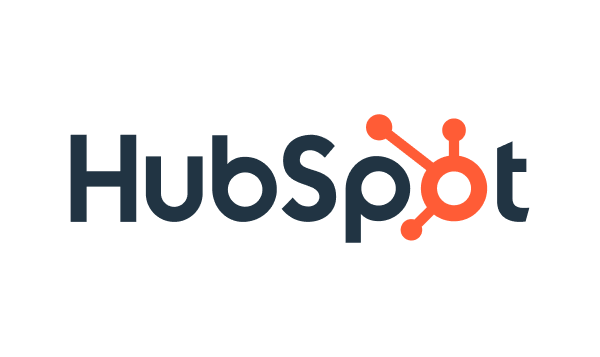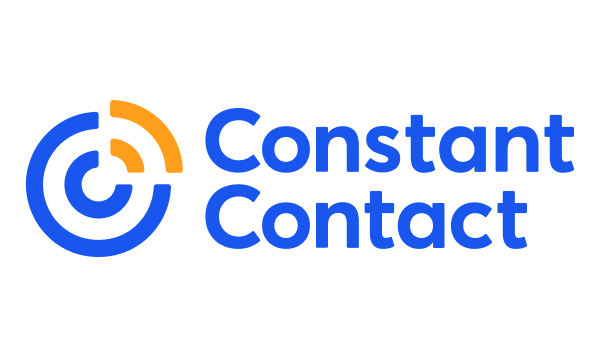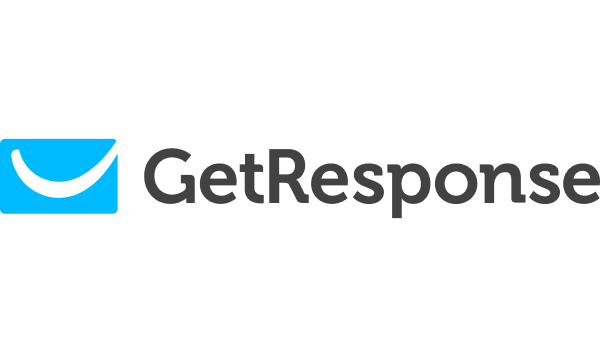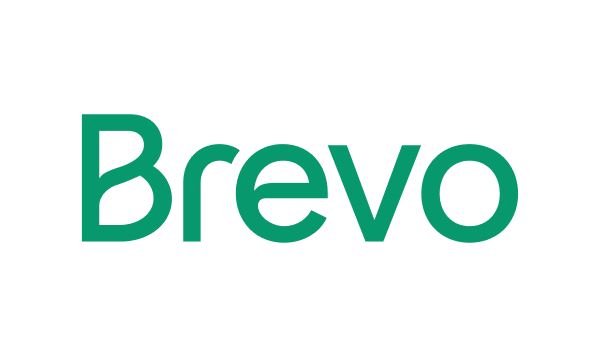Emma by Marigold positions itself as a team-friendly email marketing platform with professional template design and multi-location collaboration features. However, its high starting price of $99 per month and clunky email builder have left many users—including mid-size businesses, Emma’s main audience—searching for more affordable email marketing services.
If you’re considering a switch from Emma, I’ve tested and compared the top Emma competitors to help you make informed decisions about your financial path forward.
30-Second Verdict: Which Emma Alternative Should You Choose?
If you need a quick answer, here’s our recommendation after testing all eight platforms:
- Best All-Around Value: Sender—At $7/month versus Emma’s $99/month, Sender delivers exceptional value with a generous free plan (2,500 contacts, 15,000 emails), unlimited automation on all tiers, and integrated SMS marketing. If you want Emma-level features without the enterprise price tag, start here.
- Best for Ecommerce: Klaviyo—Purpose-built for online stores with deep Shopify and WooCommerce integration, predictive analytics, and automation triggered by real-time purchase behavior. Starting at $20/month, it’s the ideal solution for ecommerce brands.
- Best for Multichannel on a Budget: Brevo—Combines email, SMS, WhatsApp, and CRM in one dashboard starting at $8/month, with a free plan offering 300 daily emails and 100,000 contacts. Ideal for teams wanting multichannel reach without juggling multiple tools.
Scroll down for a side-by-side comparison and detailed breakdowns of each platform.
Why Consider Emma Alternatives?
While Emma offers solid email marketing capabilities, several significant drawbacks make all the alternatives worth considering.
- No Free Tier: Unlike many of its competitors, Emma does not offer a free plan or trial period, making it more difficult for small businesses or startups to test the platform’s capabilities before committing financially.
- High Starting Price: Emma pricing begins at $99/month—significantly higher than competitors offering similar or better features. For businesses focused on financial planning and long-term growth, this creates an unnecessary burden on marketing budgets.
- Annual Contracts Only: Emma’s plans are locked behind annual contracts, which can be a hurdle for businesses looking for more flexible, month-to-month billing options. This can add extra pressure to your financial future planning and commitments.
- Limited Template Customization: While Emma provides a variety of professional templates, customization options can be restrictive. Many users find the platform’s template design options somewhat rigid, making it challenging to achieve highly tailored email campaigns without additional effort. (G2)
- Clunky Email Builder: Although Emma offers a drag-and-drop editor, user feedback highlights issues with formatting inconsistencies between email previews and the final sends. Some find the interface less intuitive compared to modern competitors, which offer smoother, more user-friendly design experiences. (G2)
- Lacks Advanced Testing: Emma provides basic A/B testing but falls short of the more advanced multivariate testing features offered by many top competitors. This can be a limitation for larger organizations that need more in-depth performance optimization.
Emma Competitors: Quick Comparison Table
| Platform | Best For | Starting Price | Key Advantage | G2 Rating |
| Sender | Overall Best Alternative | $7/month (Free plan available) | Generous free plan with full automation | 4.7/5 |
| Klaviyo | Ecommerce Data-Driven Marketing | $20/month (Free plan available) | Deep ecommerce data integration | 4.6/5 |
| HubSpot Marketing Hub | All-in-One Platform | $917/month (Free plan available) | Complete marketing ecosystem | 4.4/5 |
| Mailchimp | Most Popular for Email Marketing | $13/month (Free plan available) | 300+ integrations, brand recognition | 4.3/5 |
| Campaign Monitor | Design-Focused Alternative | $12/month (Free trial available) | Premium template design quality | 4.5/5 |
| Constant Contact | Event Marketing Features | $12/month (Free trial available) | Built-in event management tools | 4.2/5 |
| GetResponse | Webinars & Sales Funnels | $16/month (Free plan available) | Included webinar hosting | 4.3/5 |
| Brevo | Budget Multichannel Option | $8/month (Free plan available) | Multichannel platform | 4.5/5 |
Quick Picks: Find the Perfect Emma Alternatives Fast
Use this list to quickly match your business needs with the right email marketing platform.
- Best Free Plan: Sender (2,500 subscribers + 15,000 emails/month with full automation and 24/7 support.)
- Best for Ecommerce: Klaviyo (Deep Shopify/WooCommerce integration, predictive analytics, and behavior-triggered automation.)
- Best for Startups/SMBs: Sender (Enterprise features at $7/month with intuitive setup—no technical expertise required.)
- Best Budget Option: Brevo (Email, SMS, and WhatsApp from $8/month with 100,000 contacts on the free tier.)
- Best for Enterprise/Agencies: HubSpot (Complete CRM + marketing ecosystem with 1,000+ integrations and advanced attribution.)
- Best for Events & Nonprofits: Constant Contact (Built-in event management, ticketing, and up to 30% nonprofit discounts.)
- Best for Webinars & Courses: GetResponse (Included webinar hosting for up to 1,000 attendees plus conversion funnels.)
- Best for Design-Focused Teams: Campaign Monitor (Premium templates and intuitive drag-and-drop builder for brand-conscious marketers.)
8 Best Emma Alternatives Compared
Not sure Emma’s the best fit anymore? You’re not alone. Let’s walk through some great alternatives that might better match your goals.
Sender — Best Alternative to Emma
For businesses tired of Emma’s complexity and high costs, Sender provides the simplicity and affordability that makes email marketing enjoyable again. I’ve found it to be the most balanced option for teams wanting professional results without the enterprise price tag.
Sender has built its reputation on delivering enterprise-level features at small-business prices. The platform’s easy to use interface lets you create professional email campaigns within minutes, not hours.
Sender’s free forever plan includes 2,500 subscribers and 15,000 emails monthly—generous enough for most small businesses to operate without paying a cent, unlike Emma which offers no comparable free option.
What impressed me most is Sender’s unlimited email automation even on lower-tier plans—I could set up welcome sequences, abandoned cart flows, and re-engagement campaigns without hitting paywalls or dealing with hidden fees. For teams prioritizing simplicity, flexibility, and affordable email marketing, Sender delivers personalized content capabilities at a fraction of Emma’s cost.
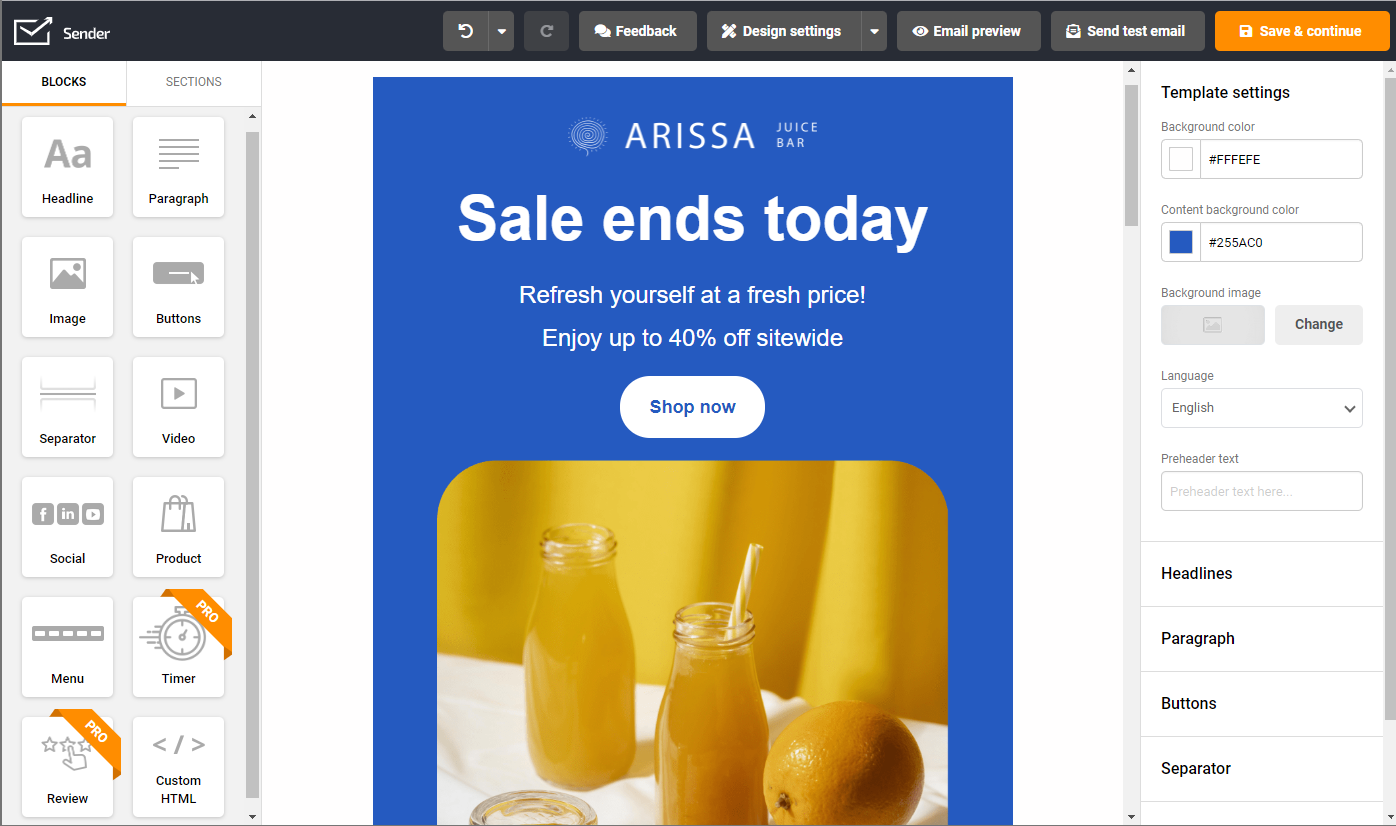
Key Features
- Drag-and-drop email builder with modern, responsive templates;
- Advanced email automation workflows;
- Integrated SMS marketing for true multichannel campaigns;
- Smart segmentation based on subscriber behavior and customer data;
- Comprehensive analytics dashboard tracking campaign performance in real-time.
Pros & Cons
- Generous free plan
- Landing page builder
- Modern, intuitive email builder
- Transactional emails
- 24/7 human support
- Sender’s branding on free version.
- SMS only in paid plans
Sender Pricing
Here’s an overview of Sender’s pricing:
- Free: $0 (2,500 contacts—15,000 emails/month);
- Standard: $7/month (1,000 contacts—12,000 emails/month);
- Professional: $14/month (1,000 contacts—24,000 emails/month);
- Enterprise: Custom pricing.
Emma vs. Sender
Sender costs just $7/month, compared to Emma’s $99/month starting price. Unlike Emma’s complex setup, Sender provides an easy, immediate start with exceptional customer support included in all plans. With modern templates and a user-friendly interface, Sender is perfect for businesses seeking simplicity and affordability without compromising features.
See why businesses choose Sender:
Klaviyo — Ecommerce Data-Driven Marketing
Klaviyo dominates ecommerce email marketing with advanced segmentation based on purchase behavior, browsing history, and customer lifetime value—features Emma lacks in comparison.
Klaviyo has earned its position as the go-to email marketing platform for serious ecommerce brands. With deep integration with Shopify, WooCommerce, and other ecommerce platforms, Klaviyo’s automation reacts to real-time purchase behavior, browsing history, and more.
Klaviyo’s automation capabilities really impressed me—you can trigger email flows based on real-time customer data such as purchases, browsing behavior, and cart abandonment, which is a game-changer compared to Emma’s limited automation options. Klaviyo’s advanced segmentation allows you to target specific customer segments with precision, making your email campaigns far more personalized.
Predictive analytics help track ROI, offering valuable insights into campaign performance and optimization. For data-driven ecommerce brands, Klaviyo’s sophisticated automation and segmentation make it the clear choice for optimizing email marketing strategies.
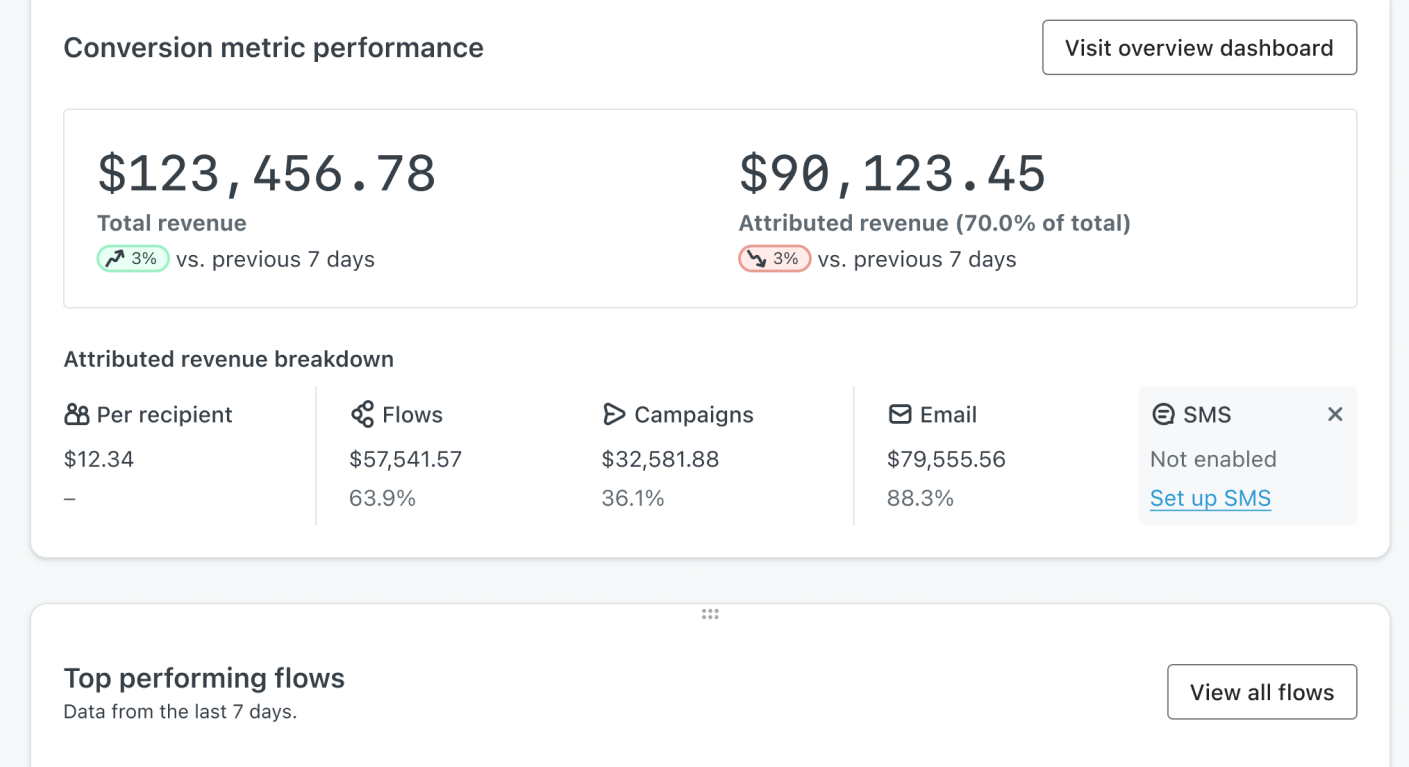
Key Features
- Deep ecommerce integrations like Shopify and, WooCommerce;
- Predictive analytics for customer lifetime value and churn risk;
- 350+ professionally designed email templates optimized for conversions;
- Advanced marketing automation with 80+ pre-built flow templates;
- SMS, push notifications, and product reviews all integrated in one platform.
Pros & Cons
- Revenue attribution and ROI tracking
- Visual workflow editor
- Deep ecommerce integration
- Stunning predictive analytics
- Expensive as email lists grows
- Steep learning curve
- Primarily designed for ecommerce
- Limited free plan (250 profiles, 500 emails)
Klaviyo Pricing
- Free: $0 (250 contacts—500 emails/month, includes 150 SMS credits);
- Email: $20/month (500 contacts—5,000 emails/month);
- Email + SMS: $20/month (500 contacts—5,000 emails/month, includes 150 SMS credits).
Emma vs. Klaviyo
Klaviyo starts at $20/month versus Emma’s $99/month, while providing ecommerce-specific features Emma completely lacks. Klaviyo’s automation is purpose-built for online sales, while Emma’s generic tools require expensive customization to achieve similar results.
For large businesses making informed decisions about their email marketing platform, Klaviyo offers more sophisticated tools—though at a higher price point that scales with your list.
HubSpot Marketing Hub — All-in-One Platform
HubSpot provides comprehensive marketing, sales, and service tools in one platform, eliminating the need for multiple tools that Emma often requires through expensive integrations. While Emma focuses solely on email campaigns, HubSpot includes CRM, landing pages, social media management, and analytics that create a complete marketing ecosystem.
I found HubSpot’s Marketing Hub to be a different beast entirely compared to Emma’s standalone email tools. The CRM-integrated marketing automation and contact management are genuinely powerful—you can create multi-step workflows triggered by behaviors across email, forms, and website interactions, which makes nurturing leads feel less like guesswork.
The segmentation tied to CRM customer data means you’re personalizing based on detailed profiles, not just basic email lists. Yes, pricing can climb to enterprise levels quickly, but there’s a functional free tier that actually lets you do meaningful work.
For teams outgrowing Emma’s limited scope, HubSpot provides the comprehensive solution needed to scale marketing efforts without switching between multiple expensive tools.
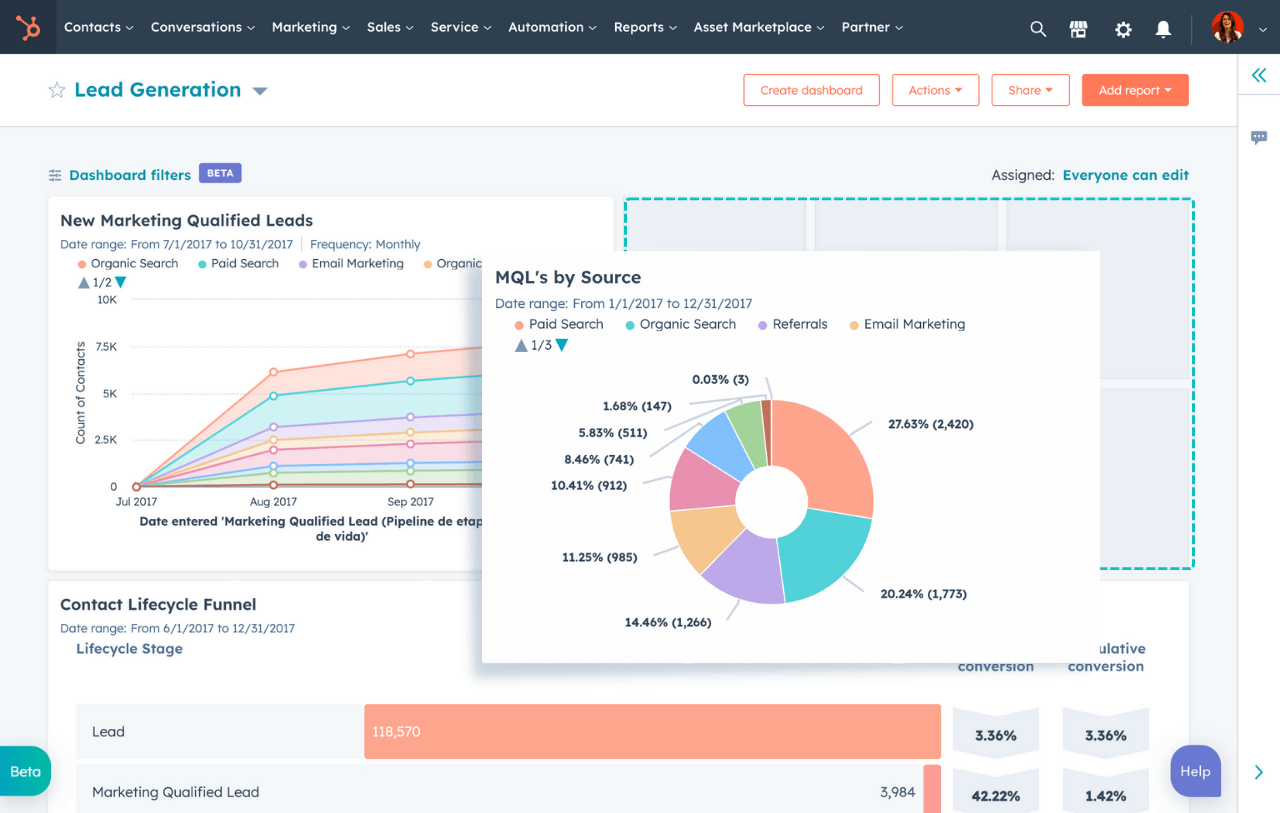
Key Features
- Integrated CRM with complete customer interaction history;
- AI-powered content and campaign recommendations;
- Advanced multi-touch attribution reporting;
- Built-in SEO tools and content management system;
- Landing page builder with A/B testing capabilities.
Pros & Cons
- Truly all-in-one platform eliminating tool fragmentation
- Powerful marketing automation with visual workflow builder
- Feature-rich free plan
- Strong integration ecosystem with 1,000+ apps
- Excellent analytics and attribution reporting tools
- Can be overwhelming for email-only needs
- Steep price increases
- Some integrations can be tricky to set up
HubSpot Pricing
- Free: $0 (2,000 email sends/month);
- Marketing Hub Starter: $10/month (up to 1,000 contacts—5,000 emails/month);
- Marketing Hub Professional: $917/month (up to 2,000 contacts—20,000 emails/month).
Emma vs. HubSpot
HubSpot offers far more than Emma’s email-only approach, combining CRM, landing pages, social media tools, and detailed analytics into one neat platform. Its all-in-one design toolkit eliminates the need for Emma’s costly third-party integrations while providing advanced automation and professional templates even on its free tier.
Mailchimp — Most Popular Budgeting App for Email Marketing
Mailchimp, a veteran of the email marketing software industry, offers reliable tools that come with its established reputation, while balancing simplicity and capability. The platform’s intuitive email templates and massive integration library offer accessibility that Emma’s complex setup process can’t match.
What I like about Mailchimp is how easy it is to use. The drag-and-drop email builder is genuinely intuitive—mobile-optimized email templates, product blocks, and customizable design tools make creating email campaigns quick, even if you’re just getting started. There’s no steep learning curve to wrestle with.
Mailchimp’s email automation is where it shines. You can set up workflows triggered by customer actions like purchases or sign-ups, and the A/B testing helps you figure out what actually works—subject lines, send times, content variations.
With 300+ integrations covering ecommerce platforms and CRMs, your customer data stays synced without manual effort. The free plan lets you test these features before committing, which is useful for teams still evaluating their options.
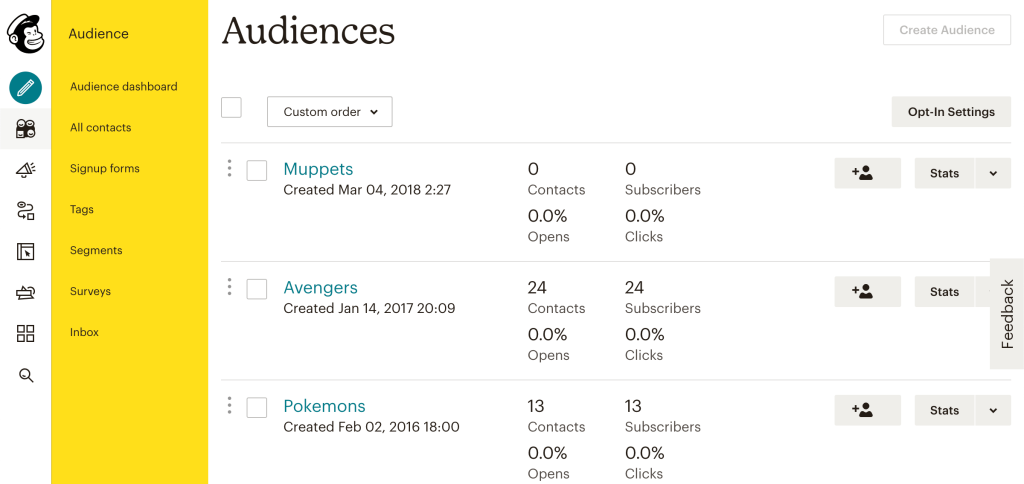
Key Features
- Extensive email templates library with AI-powered content optimizer;
- Customer Journey Builder for sophisticated marketing automation;
- 300+ integrations;
- AI-powered content optimization for better campaign performance;
- Built-in landing page builder.
Pros & Cons
- Wide range of integrations
- User-friendly interface
- State-of-the-art AI tools
- Real-time analytics
- Charges for inactive or unsubscribed contacts
- Pricing increases significantly as lists grow
- Advanced automation limited to higher tiers
- Free tier support limited to first 30 days
Mailchimp Pricing
- Free plan: $0 (500 contacts—1,000 emails/month);
- Essentials: $13/month (500 contacts—5,000 emails/month);
- Standard: $20/month (500 contacts—6,000 emails/month);
- Premium plan: $350/month (10,000 contacts—150,000 emails/month).
Emma vs. Mailchimp
Mailchimp is known for its ease of use, polished templates, and ready-to-go automation—making it ideal for beginners and small businesses. However, Mailchimp pricing can become a concern as lists grow, with rising costs being the main drawback. Meanwhile, Emma focuses only on email marketing and often requires costly services to match Mailchimp’s built-in functionality.
Campaign Monitor — Design-Focused Alternative
Campaign Monitor, also owned by Marigold, like Emma, excels in creating beautifully designed email campaigns with professional-grade templates that require minimal design expertise.
Campaign Monitor is genuinely easier to work with than Emma, especially when it comes to design. I’ve found the drag-and-drop editor to be really smooth—you can create polished, responsive emails without fighting the interface. The email templates look professional out of the box and actually render correctly across devices.
What surprised me is how much more you get for less. Campaign Monitor offers solid email automation and advanced segmentation for targeting specific customer data segments—features that Emma locks behind higher tiers.
And if you don’t need the collaboration complexity that Emma offers, Campaign Monitor is a great alternative for smaller teams or solo marketers. While it also provides team collaboration features like role-based access and approvals, its simplicity and ease of use make it better suited for teams that don’t need such extensive coordination.
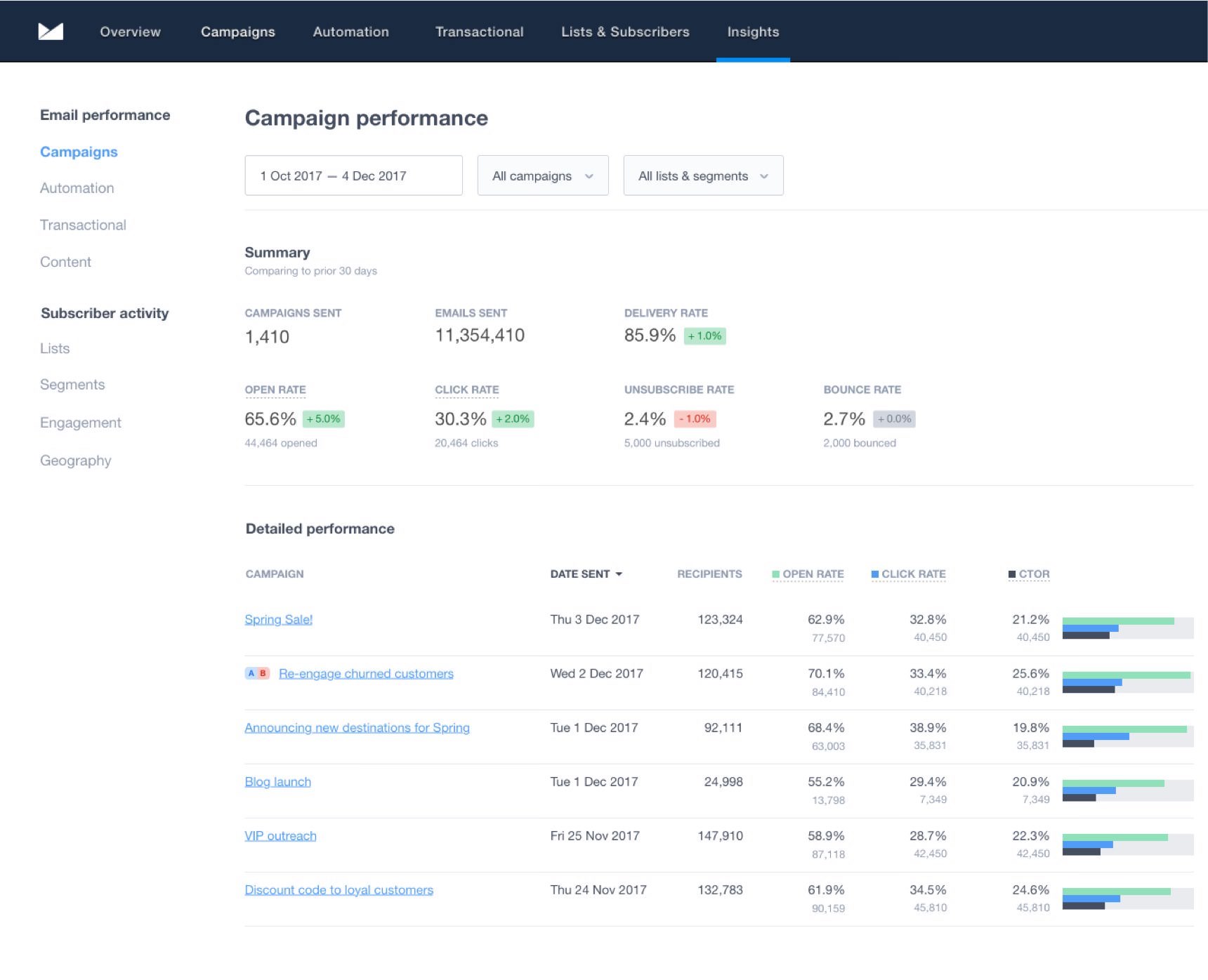
Key Features
- Drag-and-drop email builder with professional templates;
- Engagement-based segmentation for targeted personalized content;
- Link Review ensuring all links work before sending;
- Time Zone Sending for optimal delivery timing;
- Detailed click maps and engagement reporting.
Pros & Cons
- Robust drag‑and‑drop email builder
- Strong analytics and advanced reporting capabilities
- Top-tier customer support
- Seamless ecommerce integrations
- No free plan (only 30-day trial)
- Pricing can get expensive as lists grow
- SMS requires add-ons
Campaign Monitor Pricing
- 30-day free trial: $0 (100 email sends);
- Lite: $12/month (500 contacts—2,500 emails/month);
- Essentials: $29/month (500 contacts—Unlimited email sends);
- Premier: $159/month (500 contacts—Unlimited email sends).
Emma vs. Campaign Monitor
Campaign Monitor stands out with its advanced design tools and seamless team collaboration features, making it a powerful option for modern email marketing. Its templates are polished, contemporary, and ready to use, while Emma’s often appear dated and usually demand expensive customization.
Constant Contact — Event Marketing Features
Constant Contact has carved a unique niche by combining solid email marketing with integrated event management tools that few competitors offer.
Constant Contact stands out among alternatives to Emma for businesses that regularly host events, webinars, or in-person gatherings. The platform’s event management capabilities—including registration pages, ticket sales, and automated attendee communications—make it invaluable for nonprofits, real estate agencies, and community organizations.
Where Constant Contact impressed me is its AI-assisted Campaign Builder, which helps generate email, social, and ad content quickly with minimal effort. Its email editor and email templates make designing email campaigns easy, and built-in list management and email automation let you trigger welcome emails and basic workflows without complexity.
Add in social media integrations and phone support on all paid plans, and you’ve got a well-rounded email marketing platform that punches above its price point.
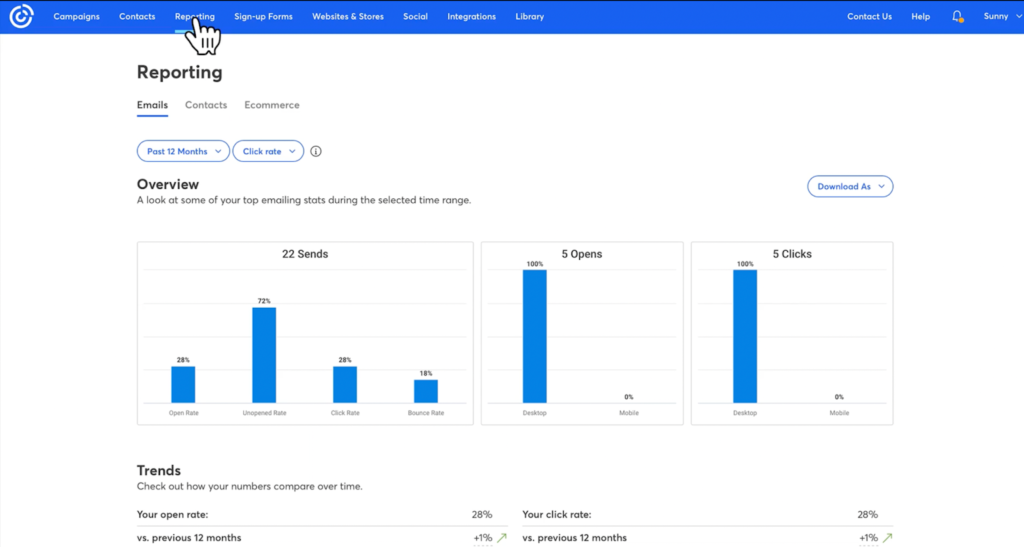
Key Features
- Integrated event management with registration and ticketing;
- AI Campaign Builder for multichannel campaigns;
- BrandKit that automatically pulls brand assets from your website;
- Social media posting and management tools;
- Phone support available on all paid plans.
Pros & Cons
- Intuitive interface
- Unique event marketing integration
- Phone support
- AI Campaign Builder
- Easy to use interface for beginners
- Limited automation compared to modern alternatives
- No free plan (only 60-day trial)
- A/B testing less advanced than competitors
Constant Contact Pricing
- Lite: $12/month (500 contacts—5,000 emails/month);
- Standard: $35/month (500 contacts—6,000 emails/month);
- Premium: $80/month (500 contacts—12,000 emails/month).
Emma vs. Constant Contact
Constant Contact serves a different audience than Emma, excelling particularly for event-driven organizations and nonprofits. While Emma focuses on team collaboration and mid-market businesses, Constant Contact’s event management tools and nonprofit discounts make it ideal for community organizations.
For businesses where events are central to marketing strategy, Constant Contact offers capabilities that Emma email marketing simply doesn’t match.
GetResponse — Webinars & Sales Funnels
GetResponse differentiates itself by including webinar hosting and conversion funnel tools that most email marketing platforms charge extra for or don’t offer at all. While Emma focuses primarily on email marketing and collaboration tools, GetResponse gives you a broader toolkit at a competitive price.
GetResponse is known for its all-in-one capabilities. Beyond email, it provides a landing page builder, webinar hosting, and ecommerce tools, enabling businesses to handle more of their marketing in one place. Unlike Emma, which often requires expensive third-party integrations for expanded functionality, GetResponse keeps everything connected.
What I appreciate most is how approachable the email automation feels. Setting up workflows—welcome sequences, cart recovery, re-engagement triggers—is genuinely intuitive, not the headache you’d expect from a platform with this many advanced features. You don’t need a full-time marketing team to get sophisticated campaigns running.
For businesses running lead generation through content marketing and webinars, GetResponse delivers a full stack without juggling multiple subscriptions.
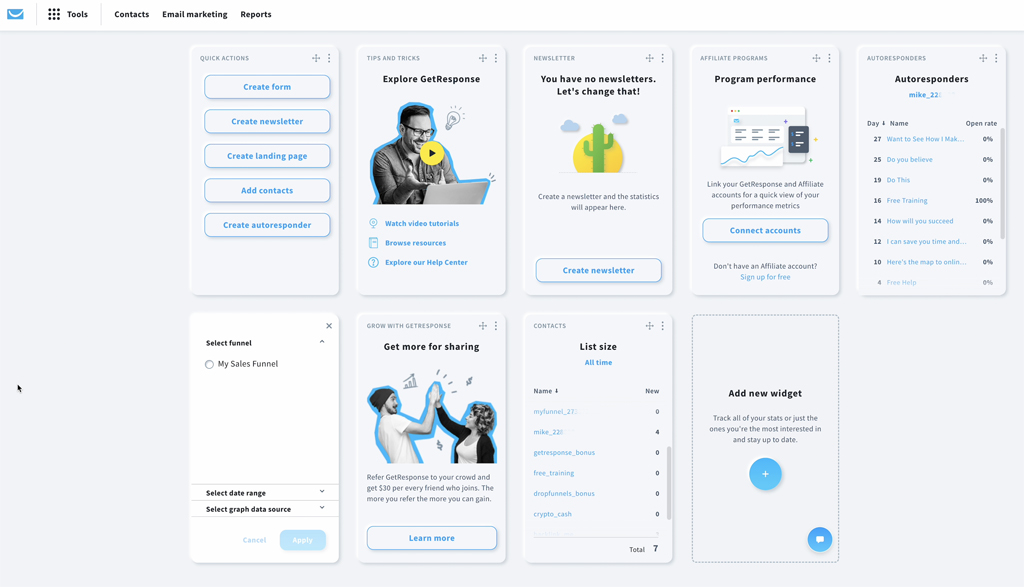
Key Features
- Built-in webinar hosting;
- Conversion funnel builder for marketing automation;
- AI-powered website and landing page builder;
- Advanced autoresponders with behavioral triggers;
Pros & Cons
- Comprehensive email and automation tools
- Built‑in landing pages and website builder
- Sales funnel and webinar tools at mid/upper tiers
- All‑in‑one marketing platform (email, automation, funnels)
- Price jumps between tiers to unlock advanced features
- Webinar and conversion tools are tied to higher plans
- A/B testing and segmentation are limited on free/entry tiers
- SMS requires higher plans
GetResponse Pricing
- Free: $0 (500 contacts—2,500 emails);
- Starter: $16/month (1,000 contacts—Unlimited email sends);
- Marketer: $48/month (1,000 contacts—Unlimited email sends);
- Creator: $57/month (1,000 contacts—Unlimited email sends);
- Enterprise: Custom pricing.
Emma vs. GetResponse
GetResponse offers capabilities that Emma doesn’t touch—particularly webinar hosting and conversion funnels. For businesses using Emma plus separate webinar software plus landing page tools, GetResponse can consolidate these costs into a single platform.
For coaches, course creators, and businesses relying on educational marketing, GetResponse provides a more complete solution than Emma by Marigold.
Brevo — Budget Multichannel Option
Brevo is a powerful tool that combines email marketing automation, CRM, SMS, and WhatsApp messaging tools in one dashboard—offering broader flexibility than Emma’s email-focused approach.
One thing that sets Brevo apart is its multichannel approach. You can run email campaigns, SMS blasts, and WhatsApp messages alongside your email automation workflows—all from one dashboard. This lets you reach customers wherever they are without juggling separate tools, which is a clear edge over Emma’s email-centric focus.
Where Brevo impressed me is how well the automation and CRM pieces connect. You can build workflows that react to subscriber behavior and manage customer data and interactions right inside the platform, which keeps marketing and sales efforts streamlined instead of scattered across tools.
Brevo also offers a free plan with 300 daily emails to get started, while Emma doesn’t have a free tier at all—making Brevo a much more accessible option for smaller teams still evaluating their email marketing platform options.
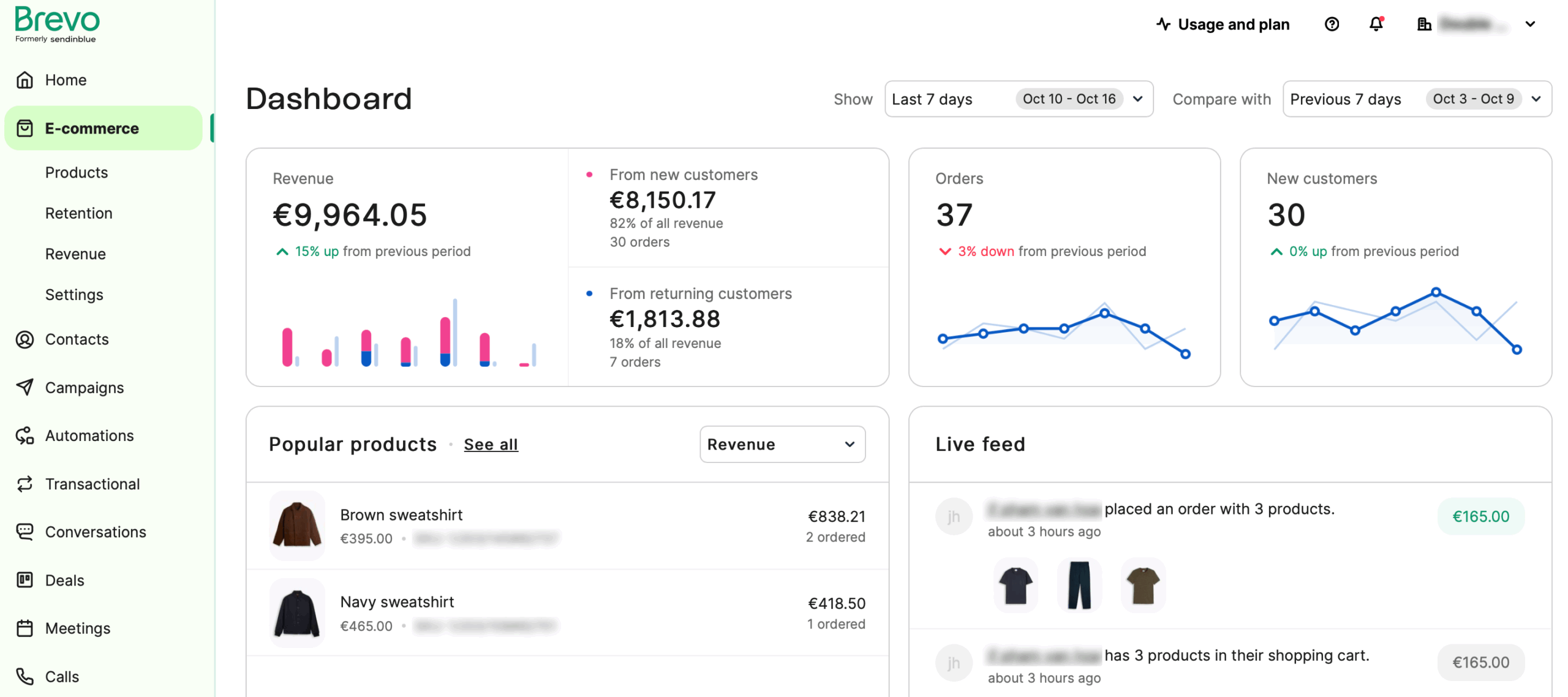
Key Features
- Integrated SMS and WhatsApp messaging;
- Built-in CRM for managing sales pipelines;
- Transactional email with high deliverability;
- Live chat and chatbot functionality.
Pros & Cons
- True multichannel platform (email, SMS, WhatsApp)
- Generous free plan (300 emails/day, 100,000 contacts)
- Intuitive-drag-and-drop builder
- Strong automation
- Free plan limited to 300 emails daily
- A/B testing for higher plans only
- Support varies by plan
Brevo Pricing
- Free: $0 (100,000 contacts—300 emails/day);
- Starter: $8/month (500 contacts—5,000 emails);
- Business: $16/month (500 contacts—5,000 emails);
- Enterprise: Custom pricing.
Emma vs. Brevo
Brevo offers something Emma simply doesn’t—a true all-in-one marketing automation platform. While Emma focuses mainly on email, Brevo combines email, SMS, WhatsApp, and CRM tools in a single dashboard. This means you can run multichannel campaigns without paying for separate tools or wrestling with integrations.
For budget-conscious businesses seeking affordable email marketing with multichannel capabilities, Brevo delivers far more flexibility than Emma pricing at a lower entry point.
How to Choose the Right Emma by Marigold Alternative
If you’re deciding on an Emma alternative, it’s important to weigh several factors—from ease of use to the specific features your business may require. Our rule of thumb? Start with free email marketing platforms like Sender or Brevo, test their functionality and commit to a subscription only after it checks all the boxes.
- Assess your budget constraints. If Emma email marketing pricing strains your budget, consider Sender’s free plan or Brevo $8/month option for full features. These alternatives to Emma provide professional email marketing and transparent pricing, so you can focus on your financial health.
- Evaluate your technical expertise. Choose platforms with intuitive interfaces if you lack technical staff, as Emma often requires professional setup assistance. Sender and Mailchimp offer immediate usability without Emma’s learning curve or additional costs.
- Consider your industry focus. Ecommerce businesses should prioritize Klaviyo for sales-driven features and strong support for transactional emails, while general businesses can benefit from HubSpot’s comprehensive approach.
- Review integration requirements. Ensure your chosen alternative connects with existing tools, as Emma’s limited integration options often create additional costs. Mailchimp and HubSpot offer more extensive integration ecosystems than Emma.
- Test platform usability. Take advantage of free trials to compare ease of use, as Emma’s complexity often surprises new users. Most alternatives offer more intuitive experiences than Emma’s cumbersome interface.
- Analyze support quality. Prioritize platforms offering responsive customer support, as Emma gets bad rep for customer support problems, such as slow response times and limited accessibility. Sender’s 24/7 live chat, for instance, provides immediate assistance that Emma lacks (or only reserves for higher-tier subscribers).
How We Evaluated These Emma Alternatives
We selected the platforms on this list based on real user feedback from G2, Capterra, and other review sites, focusing on honest experiences and common pain points. To validate those insights, I tested each one to see whether they actually deliver on their promises—not just marketing claims.
User experience was a major factor. I evaluated how intuitive each drag-and-drop email builder felt, how easy it was to set up email automation, and whether beginners could get started without too much struggle. Pricing was compared closely against the features offered, with particular attention to hidden fees and restrictions that inflate costs as you scale.
I also assessed customer data handling, email templates quality, and deliverability rates to ensure these tools can support real campaign performance. Finally, I looked at customer support—response times, helpfulness, and availability—so you can get assistance when it matters most.
FAQs
What’s a good Emma alternative for nonprofits?
If budget is a priority, Sender’s free forever plan is hard to beat—2,500 subscribers and 15,000 emails monthly at no cost, plus a 25% nonprofit discount on paid plans. GetResponse offers 50% off for qualifying organizations and includes webinar tools, which is great for fundraising events. Constant Contact provides 20–30% nonprofit discounts with built-in event management for donor outreach and campaigns.
Which Emma alternative works for small teams on a budget?
Sender is the clear winner for budget-conscious small teams. Its free plan includes 2,500 subscribers and 15,000 monthly emails with full email automation and segmentation capabilities— powerful features that Emma charges $99/month or more to access. Brevo is another strong contender with its 300 emails/day and 100,000 contacts free plan, perfect for teams with large lists but moderate sending needs.
Why do brands switch from Emma?
The most common reasons include: Emma pricing that starts at $99/month (significantly higher than alternatives), a clunky drag-and-drop email builder with formatting inconsistencies, and no free plan to test features. When there’s so many free alternatives that match Emma’s capabilities plus more, many users feel Emma is not worth the price.
Can I migrate my contacts from Emma easily?
Yes, most alternatives to Emma support CSV imports, making contact migration straightforward. The key is ensuring your export includes all relevant customer data fields like tags, custom fields, and engagement history. Most platforms can complete migration within a day, though rebuilding automation workflows takes additional time regardless of which alternative you choose.
Disclaimer: This article evaluates Emma alternatives, including Sender, which our company owns. Assessments are based on research, industry standards, and user feedback. No commissions are earned from links in this article.




